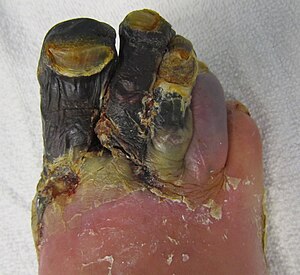Gangrene
| Gangrene | |
|---|---|
 |
|
| Dry gangrene affecting the toes as a result of peripheral artery disease | |
| Classification and external resources | |
| Specialty | Infectious disease, general surgery |
| ICD-10 | R02, I70.2, E10.2, I73.9 |
| ICD-9-CM | 040.0, 785.4 |
| DiseasesDB | 19273 |
| MedlinePlus | 007218 |
| eMedicine | article/217943 article/782709 article/214992 article/438994 article/2028899 article/2051157 |
| Patient UK | Gangrene |
| MeSH | D005734 |
Gangrene (or gangrenous necrosis) is a type of necrosis caused by a critically insufficient blood supply. This potentially life-threatening condition may occur after an injury or infection, or in people suffering from any chronic health problem affecting blood circulation. The primary cause of gangrene is reduced blood supply to the affected tissues, which results in cell death.Diabetes and long-term smoking increase the risk of suffering from gangrene.
Gangrene is not a communicable disease; it does not spread from person to person, though the infection associated to some forms can. The types of gangrene differ in symptoms, and include dry gangrene, wet gangrene, gas gangrene, , and necrotizing fasciitis. Surgical removal of gangrenous tissue and antibiotics are the mainstays of treatment for gangrene. After the gangrene is treated, the underlying cause is addressed. This includes lifestyle modification such as smoking cessation, better control of diabetes, revascularization or, rarely, medical therapy to stop vascular spasm or the production of cold-induced vascular obstruction by cold-precipitated cryoglobulins.
Gangrene is caused by a critically insufficient blood supply (e.g., peripheral vascular disease) or infection. It is associated with diabetes and long-term tobacco smoking. This condition most commonly occurs in the lower extremities (legs and feet).
Dry gangrene is a form of coagulative necrosis that develops in ischemic tissue, where the blood supply is inadequate to keep tissue viable. Dry gangrene is often due to peripheral artery disease, but can be due to acute limb ischemia. The limited oxygen in the ischemic limb limits putrefaction and bacteria fail to survive. The affected part is dry, shrunken and dark reddish-black. The line of separation usually brings about complete separation, with eventual falling off of the gangrenous tissue if it is not removed surgically, a process called autoamputation.
...
Wikipedia
